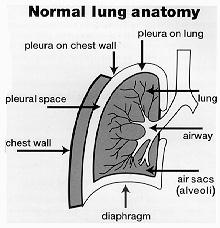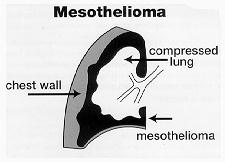Throughout the past decade, the term "mesothelioma" has become more and more recognizable. Once an obscure disease that meant little to the general public, mention of this disease now conjures up thoughts and pictures of factories and mines strewn with asbestos and the unfortunate workers who were employed in those dangerous places.
Thanks to concerned medical professionals, researchers, and watchdog organizations, we're learning more and more about mesothelioma and how it affects the lives of those who are afflicted. However, there's still far to go as both better treatments and a cure for the disease are sought.
About the Disease
Simply put, mesothelioma which is commonly referred to as asbestos cancer, is an aggressive cancer caused primarily by the inhalation of dangerous asbestos fibers. The disease attacks the mesothelium, a protective, two-layered membrane that covers the internal organs of the body including the lungs, heart and abdominal organs. Between these layers, the cells produce fluid, which allows easy movement of the heart and lungs within the chest cavity. The layer that covers the lungs is called the pleura, and the layer that covers the heart is called the pericardium. The peritoneum lines the abdominal cavity. Mesothelium also lines the male and female reproductive organs. Mesothelioma can affect any of these cells, but is usually seen in the pleural or peritoneal mesothelium. The most commonly diagnosed form of this cancer is pleural mesothelioma.
Mesothelioma takes anywhere from 20 to 50 years to develop, which is why older individuals are usually the victims. However, recent cases involving September 11th World Trade Center first responders and clean-up crews show that high concentrations of asbestos can cause the disease to develop much more rapidly. A few WTC workers have already died of the disease.
Effects of the Disease
The invasion of the mesothelium by cancer cells makes it very difficult for the patient to breathe, resulting in the need for oxygen, especially as the disease progresses. Those with the pleural form of mesothelioma may also suffer from pleural effusions. These effusions prevent the smooth movement of the lungs and other organs in the chest. Peritoneal mesothelioma also affects the stomach area and abdominal cavity, causing nausea, vomiting, or loss of appetite, which can result in dangerous weight loss. In addition to breathing difficulties and loss of appetite, mesothelioma victims also complain of excessive coughing, sleeping difficulties, persistent chest pain, fever, and pain in the lower back.
Mesothelioma, in general, is a very painful disease and because it is usually not diagnosed until it's in an advanced stage. For this reason, the symptoms are typically quite serious. Late diagnosis also means that the cancer is more likely to have metastasized, or spread, making successful mesothelioma treatment even more difficult.
Who Gets Mesothelioma?
Statistics show that, because of their work history, the disease most often affects men between the ages of 50 and 70 who were employed in an asbestos-laden environment before asbestos warnings and bans were in place in the 1970s. Though women still have a much lower frequency of the disease, cases of second-hand exposure to asbestos has prompted more diagnoses among women, especially those whose male family members worked with asbestos. The occupations most associated with mesothelioma are shipyard workers, electricians, plumbers, construction industry workers, pipefitters, boilermakers, and anyone subject to heavy exposure to dangerous asbestos and airborne asbestos fibers.
An abundance of cases have also demonstrated that mesothelioma can develop among people who lived in communities where asbestos factories or mines were located. In some instances, entire towns have been adversely affected by the presence of asbestos fibers in the air. For example, in Libby, Montana - site of a former vermiculite asbestos mine - hundreds have already died of mesothelioma.
Though still significantly rarer than other cancers, an estimated 2,000 to 3,000 new cases of mesothelioma are diagnosed each year in the United States. Other countries, notably the United Kingdom and Australia, report a much higher incidence of the disease. Nevertheless, the United States - like many other countries - has seen an increase in asbestos-caused cancer as men who worked in U.S. shipyards in the 1940s and 1950s, at the height of production, are now being diagnosed with mesothelioma.
Dealing with Mesothelioma
Mesothelioma is most often diagnosed in its late stages, and such a diagnosis is devastating to the individual and his/her family. Though research into the disease has been ongoing, there is currently no cure for mesothelioma. Some patients may be candidates for surgery to remove tumors or even an entire lung, but most are better treated with radiation or chemotherapy. More often than not, these treatments are palliative, serving to lessen the severity of the symptoms of the disease rather than offering a cure.
Medical professionals and research scientists, however, are constantly exploring new ways to combat the disease. For example, doctors know that some combinations of chemotherapy drugs work better than others and tests developed to ascertain earlier diagnosis of the disease or to monitor those most at risk have arrived on the scene.
Who's to Blame?
The reason someone develops mesothelioma is usually the lack of proper protection offered to those who worked with asbestos. Though the dangerous properties of asbestos and asbestos products have been evident for decades, many employers neglected to protect their workers from inhaling asbestos while on the job. It wasn't until public awareness of the dangers of the material were revealed in the 1970s that many employers began offering protective clothing such as respirators, gloves, aprons, and other such items to those working with asbestos on a daily basis.
Due to the negligence of employers, many companies who manufacture asbestos or products that contain asbestos have been subject to literally thousands of lawsuits filed by those who've been harmed by the material. Many of those lawsuits have come from individuals suffering from mesothelioma.









